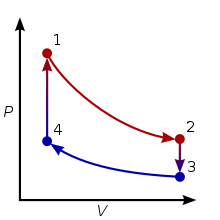
The Stirling engine is a type of external combustion heat engine that operates by the expansion and contraction of a gas enclosed within it.
Its operating principle is based on the cyclical movement of this gas between a heat source and a cold source, causing pressure variations that generate mechanical movement.
How does a Stirling engine work?
The Stirling engine operates on a regenerative thermodynamic cycle, in which the working gas undergoes cyclic compression and expansion at different temperatures. Unlike internal combustion engines, where combustion occurs within the cylinder, the Stirling engine transfers heat through the engine walls, allowing for greater efficiency and reducing pollutant emissions.
Unlike a steam engine, a Stirling engine maintains a fixed amount of gas (such as air, helium, or hydrogen) within its system, without phase changes. In a steam engine, however, the working fluid changes phase between liquid and gas, which requires complex pressure and temperature management.
The Stirling engine's displacer moves the gas cyclically between the hot and cold zones. When the gas is heated, it expands, increasing pressure and pushing a piston to generate mechanical work. The gas then cools and contracts in the cold zone, allowing the cycle to repeat. This process is synchronized by a crankshaft with a 90-degree offset between the piston and the displacer, ensuring efficient operation.
The efficiency of a Stirling engine is determined by the Carnot cycle, which states that maximum efficiency depends on the temperature difference between the hot and cold sources. Therefore, a greater temperature difference improves its performance.
The Stirling engine is a thermodynamically "closed" regenerative cycle, with cyclic compression and cyclic expansion of the working fluid at different temperature levels.
Advantages of the Stirling engine
The Stirling engine is distinguished by several features that make it an efficient and versatile alternative compared to other heat engines:
High efficiency
Compared to steam engines and internal combustion engines, the Stirling engine can achieve an efficiency close to that of the Carnot cycle, the theoretical efficiency limit for any heat engine.
Its performance is particularly high when operating with constant and long-term sustainable heat sources, such as concentrated solar power or waste heat from industrial processes.
Silent operation
Unlike internal combustion engines, the Stirling engine does not produce intense explosions or vibrations, as its process of expansion and compression of the working gas occurs smoothly and continuously.
This makes it ideal for applications where noise is a critical factor, such as in submarines, domestic generators, and refrigeration systems.
Use of various heat sources
One of its greatest advantages is its ability to operate with virtually any external heat source. It can use fossil fuels, biomass, solar energy, industrial waste heat, geothermal energy, or even the temperature difference between water and air in marine environments.
Low emission of pollutants
By not requiring direct internal combustion, the Stirling engine significantly reduces the emission of harmful gases and polluting particles. Its environmental impact is minimal, especially when powered by renewable sources or waste heat.
Durability and low maintenance
Because it is not subjected to high explosive pressures or intense wear of its internal components, the Stirling engine has a long lifespan and requires less maintenance compared to internal combustion engines.
Its sealed, airtight design minimizes wear and tear on moving parts, reducing long-term operating and maintenance costs.
Ability to operate in extreme environments
Thanks to their design and operation based on the expansion of a working gas, Stirling engines can operate in extreme temperature conditions, such as in outer space or in power generation systems in polar regions.
Stirling Cycle
The ideal cycle of a Stirling engine consists of 4 phases:

- Isothermal expansion (1-2): The gas is heated and expands through an isothermal process, generating mechanical work.
- Isochoric cooling (2-3): The gas gives up heat to the regenerator, reducing its internal energy at constant volume through an isochoric process.
- Isothermal compression (3-4): The gas is cooled and compressed, reducing its volume and increasing its density.
- Isochoric heating (4-1): The gas recovers heat from the regenerator and is heated at constant volume, restarting the cycle.
Stirling engine applications
Stirling engines have applications in various fields, including:
- Power generation: They are used in solar thermal energy systems and in generating electricity from industrial waste heat. In some projects, they have also been implemented in nuclear energy as thermal converters.
- Propulsion and automotive: Stirling engine prototypes have been developed for vehicles and vessels, taking advantage of their efficiency and low noise level.
- Refrigeration and heat pumps: Thanks to their ability to operate in reversible mode, Stirling engines can act as heat pumps for heating or cooling, applied in high-efficiency air conditioning systems.
- Aerospace Applications: NASA and other agencies have explored the use of the Stirling engine for power generation in space probes and lunar bases, taking advantage of its ability to operate in extreme environments.
History and development
The Stirling engine was invented in 1816 by Scottish engineer Robert Stirling, with the aim of developing a safer alternative to the steam engine, which at the time posed risks of explosions due to high water vapor pressures. Initially, the Stirling engine was conceived as an industrial engine to compete with the steam engine. However, its use was limited to domestic and low-power applications for more than a century.
Today, it remains a subject of research and development, particularly due to its ability to operate with any external heat source. This versatility allows it to utilize solar energy, biomass, waste heat, or even geothermal sources, making it an attractive option for sustainable applications.